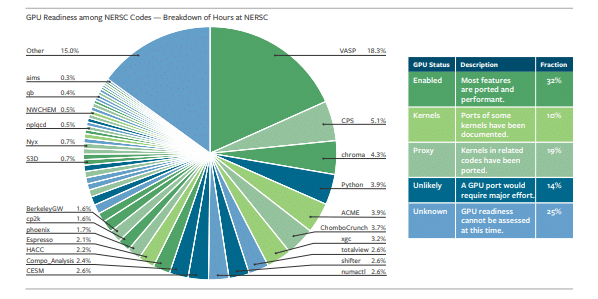NVIDIA GPUs will power a next-generation supercomputer at Lawrence Berkeley National Laboratory, announced today by U.S. Energy Secretary Rick Perry and supercomputer manufacturer Cray.
Perlmutter, a pre-exascale system coming in 2020 to the DOE’s National Energy Research Scientific Computing Center (NERSC), will feature NVIDIA Tesla GPUs. The system is expected to deliver three times the computational power currently available on the Cori supercomputer at NERSC.
Tesla GPUs provide universal acceleration for scientific computing, AI and machine learning applications, reducing the time it takes to make groundbreaking discoveries. Research organizations large and small are recognizing this potential by turning to GPUs for next-generation supercomputers.
Optimized for science, the supercomputer will support NERSC’s community of more than 7,000 researchers. These scientists rely on high performance computing to build AI models, run complex simulations and perform data analytics. GPUs can speed up all three of these tasks.
Half of NERSC Workload Can Run on GPUs
Nearly half the workload running at NERSC is poised to take advantage of GPU acceleration, a recent NERSC study found. Between now and 2020, other applications that are algorithmically similar to GPU-accelerated kernels could also make the shift to GPU-ready code — enabling scientists to hit the ground running as soon as Perlmutter comes online.
“Perlmutter will be NERSC’s first large-scale GPU system, with a heterogeneous combination of CPU and GPU-accelerated nodes designed to maximize the productivity of our diverse mix of applications,” said Nick Wright, chief architect of the Perlmutter system. “While the adoption of GPUs will benefit many codes immediately, others will require more preparation. Our NESAP effort is devoted to working hand-in-hand with our partners at NVIDIA and Cray to accelerate as many codes as possible and make Perlmutter a success for all of our users.”

Bringing Scientists Faster Breakthroughs
The demand for GPU computing for science applications has skyrocketed over the past decade. And with RAPIDS, our new open-source libraries for GPU-accelerated data analytics, these speedups can be leveraged by more kinds of workloads than ever.
At NERSC, DOE labs and universities make up the lion’s share of HPC demand. These scientists process exabytes from sensors such as radio telescopes, particle accelerators, electron microscopes and more to answer the biggest questions in their research areas:
- Nuclear fusion: Nuclear fusion reactions, the processes that fuel stars, create huge amounts of energy. Scientists have been conducting these reactions in controlled environments for years, but haven’t yet been able to sustain a fusion reaction for long enough to leverage this clean power source. Supercomputers are used to simulate plasma behavior during fusion, helping researchers understand the complex dynamics at play.
- Climate and environment: Accurately forecasting climate at a global scale is key to understanding the long-term effect of carbon emissions on the planet. GPUs allow researchers to project decades of global climate data faster and at finer resolution.
- Materials science: Every material, natural or synthetic, has molecular properties that make it useful for some tasks over others. A high level of compute power lets researchers more quickly analyze molecular structures and discover new materials that have desired qualities such as flexibility, heat resistance or strength. These new materials can then be developed for everyday items like better car batteries or more comfortable contact lenses.
- Biological sciences: Taking a close look at molecular structure is also an essential component of drug discovery and vaccine development. Researchers with access to computational resources can anticipate how potential drug molecules might work to fight disease before testing physical samples in a lab. This helps narrow down the candidates for clinical testing, shrinking the time it takes to discover promising treatments.
With the GPU-accelerated speedups Perlmutter will offer, scientists will be able to iterate faster on these projects. They’ll gain the flexibility to ask more questions of their data, while spending less time waiting and more time inferring.
Main image for this story shows a materials science research simulation of indium nitride nanostructures for more efficient LEDs. Image credit: Burlen Loring, Berkeley Lab. Courtesy of NERSC.